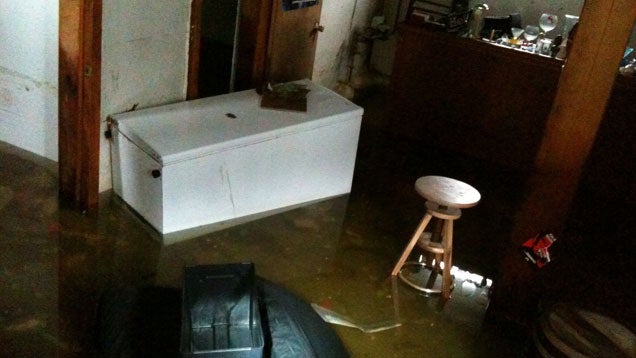
Indoor flooding can cause thousands of dollars worth of damage to your home, and it's a nightmare to clean up. Here's what to do when you notice water damage and how to safely begin the process of remediation.
The longer water is allowed to stand, the more severe the damage will be. You must respond to a flooding crisis quickly and efficiently.
Check for Danger
Before doing anything, ensure the damaged area is safe to work in. Your main concern is electrical danger. As you approach a water damaged area, check for light fixtures and appliances that may have been damaged before, during or after the flood.
Be sure hot wires are not exposed as you begin to assess damage. If there is any risk of shock exposure, immediately turn off the power to the building and resolve the danger first.
Identify the Source
Water damage can come from three general sources:
- Category I is clean, potable (drinkable) water. This is water comes from an overflowing sink, bathtub, broken water supply line or a fixture shut-off valve. This is the preferred source should water damage occur, since it poses minimal risk of contamination or respiratory danger.
- Category II water is sometimes called "gray" water. It is not drinkable, but also not full of sewage. Category II water can include dishwasher run-off or washing-machine run-off. These sources contain soap and/or food contaminants but not raw sewage.
- Category III water, sometimes called "black" water, is highly contaminated. It contains bacteria or chemicals harmful to touch, consume or inhale. Category III water must be removed by a professional with proper immunizations and personal protective equipment. Category III water can include any type of sewer back-up, water that has run across open ground before entering the structure, or anything related to a chemical spill.
Stop the Source
If the water is Category I or II, your next step is stopping the source. (If Category III, wait for a professional.) Be sure you know where your main shut-off valve is for your home's water supply and test it yearly to ensure proper function. If your leak is coming from an appliance or fixture with a shut-off valve, turn this valve off instead of the water to the entire building.
If a large amount of sewage is coming out of a drain line continuously there is a blockage in the sewer line or the municipal sewer system is malfunctioning in your entire neighborhood. Immediately call your city's waste water department and report the issue. They need to respond immediately to prevent the flow of sewage.
Prevent Further Damage
After you have identified and stopped the source of the water, take swift action to prevent further damage to household items and materials. This can include:
- Furnishings: Immediately relocate furnishings immersed in water or sitting on damp flooring. This is especially important for wood furnishings, or those that have a stain finish prone to bleeding. Nothing ruins carpet quicker than bleeding, wet furniture. Also, furnishings made from wood composite, like MDF, will swell quickly when exposed to water, and are impossible to dry to their original look and strength.
- Wall Coverings: Once the furnishings are out of the way, inspect the walls. If water has wicked up the drywall or plaster, immediately remove baseboards, wainscoting or wall-coverings. Water gets trapped behind these items and creates a barrier to drying, which creates a great spot for mold growth. Mold begins to grow on porous surfaces after 48-72 hours of dampness. If you encounter mold, cease your demolition and hire an expert. This is especially critical if you have children, seniors, or those with medical conditions in your home. Do not disturb the mold, as this releases spores into the air. Leave the drywall in place if no mold is present, it may be salvageable.
- Flooring: Once furnishings are removed and wall-finishes are stripped to drywall, you can address the flooring. As a general rule, carpet and cushion (pad) damaged with Category I water can be cleaned and salvaged. Carpet cushion damaged by Category II water needs to be disposed, but the carpet can be sanitized and salvaged. Flooring damaged by Category III water needs to be disposed of immediately and the slab or sub floor treated with an anti-microbial chemicals. Again, leave this to the experts. It takes proper training to safely remove flooring damaged to this extent.
Set Up for Successful Drying
Drying a water damaged building requires knowledge and tools most homeowners rarely need. You'll probably want to contact a restoration company to assist with moderate to heavy drying.
If you have light water damage, you may be able to deal with it yourself. Place floor fans approximately 12′ along the room(s) perimeter, pointing the air flow in a clockwise direction. This creates a vortex with the air, pushing the air to the outside of the room.
If you have access to a dehumidifier, place it on the perimeter of the room to capture this moisture. Be sure to run the condensate line from the dehumidifier to a drain or out of the building. Releasing the condensation into a bucket in the room just creates more moisture in the room and slows drying.
If you had a Category I loss, and the carpet is wet, pull it from the tack strip and attempt to blow air under the carpet if possible. Light damage should dry overnight using this method.
That should all get you started—remember, the worse the flood is, the more important that youg et some help from a professional. While you're at it, check out why flood insurance is a good idea for your basement or storm-prone apartment.
Photo by accarino.
from Lifehacker http://workshop.lifehacker.com/how-to-quickly-assess-and-recover-from-an-indoor-flood-1676017004
0 comments:
Post a Comment